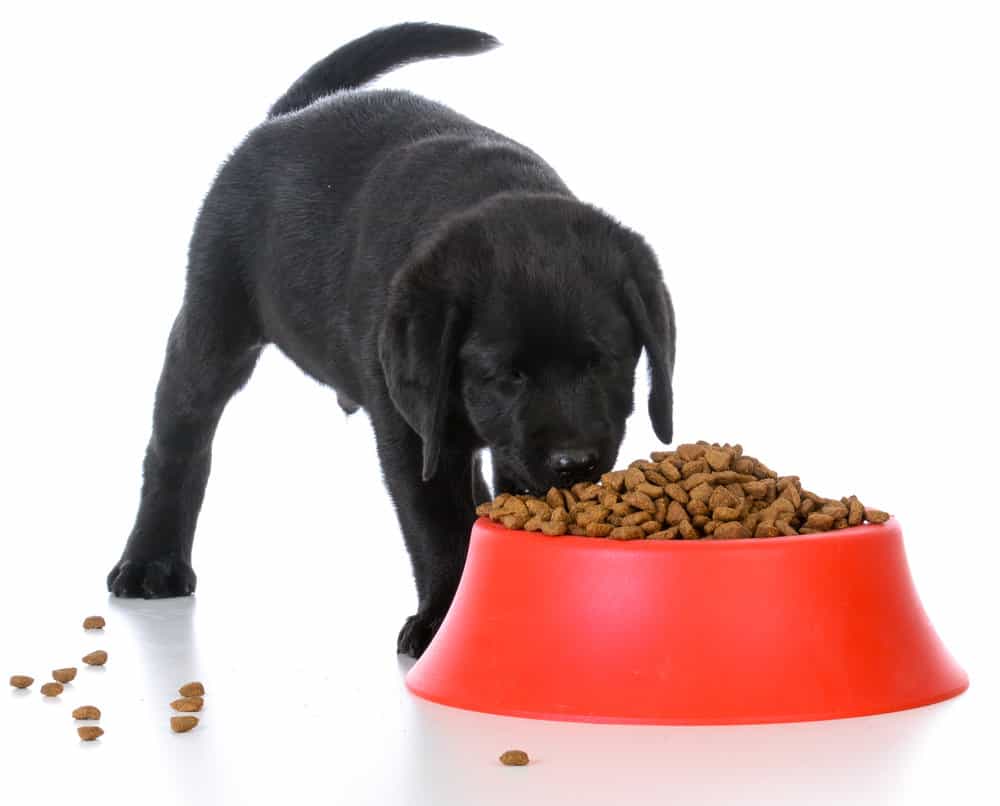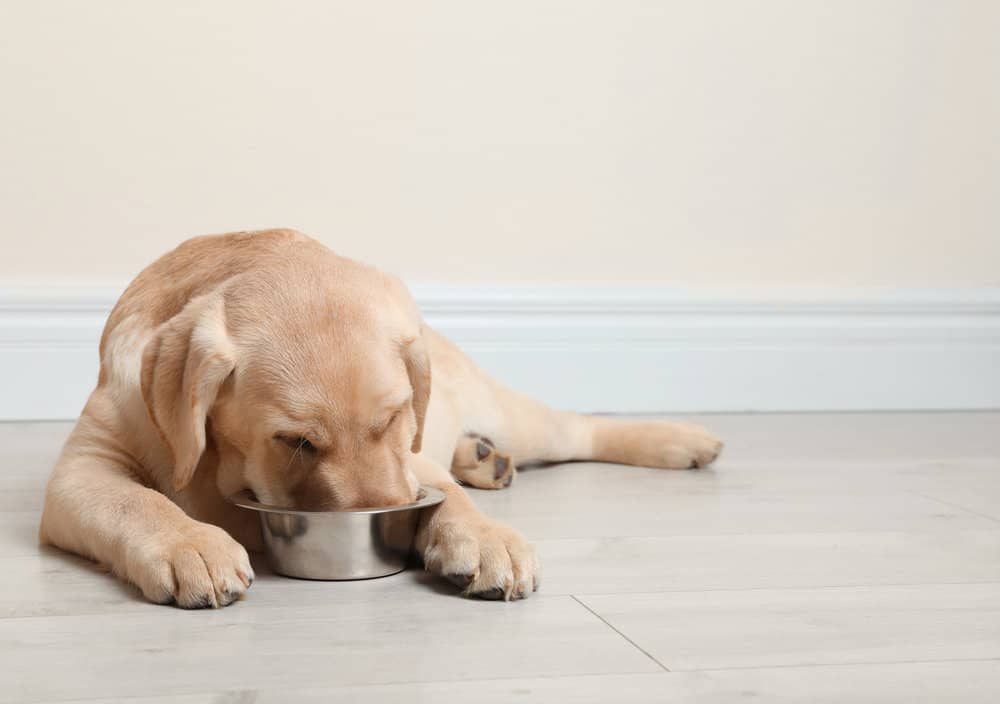The ideal time to switch from puppy food to dog food is at the adolescence stage. In Labrador puppies, that stage is often around 12 months old.
Sometimes your Lab puppy may need to switch to adult dog food a little earlier. But, on the other hand, sometimes, he’ll resist the adult dog food and may need to hold on to puppy food a little longer.
Additionally, there are signs that your puppy will show you when he’s ready to switch from puppy to adult food.
Why Do Puppies and Adult Dogs Eat Different Foods?
Puppies and dogs eat different foods because puppies need more nutrition in their meals, which puppy food provides.
Most living organisms' newborns often grow fast until they reach a certain age. To maintain that growth, those newborns require a more nutrition-dense diet.
That diet should be rich in carbohydrates to meet the growing needs of rapidly growing babies. Your labrador puppy is no exception to that rule.
On the other hand, once your Lab puppy becomes an adolescent, you need food that has less carbohydrate density to prevent giving your dog a heavy meal.
What Happens if Puppies and Adult Dogs Switch Foods?

Let’s begin by saying that nothing fatal or dangerous will happen if your puppy eats adult dog food. The same goes for the other way around. Yet, it’s not something you’d want to do.
If your Lab puppy eats adult dog food, he won’t get the required nutritional value. Puppies need a specific balance of nutrients to be perfectly healthy, which isn’t present in adult food.
Additionally, your puppy may experience some stomach upset and may not gain as much weight as he needs to.
On the other hand, feeding puppy food to your adult Lab won’t necessarily cause any stomach problems. But you run the risk of overfeeding your dog.
The high-calorie intake in puppy food will add more pounds to your dog’s weight than you like.
Your dog will be heavier, less active, and less healthy. Additionally, he’ll need to use the bathroom more often.
Helpful Dog Training Resource:
For help with training your dog, you should take a look at The Online Dog Trainer by Doggy Dan. Doggy Dan is an expert Dog Trainer based in New Zealand. His online resource contains Hundreds of Excellent Dog Training Videos that will take you step-by-step through the process of developing a healthy, happy well-behaved dog.
How to Determine if Your Labrador Puppy Is Ready for Dog Food?
Labrador puppies will show some signs when they’re ready to switch from puppy food to dog food. These signs are:
- Less interest in puppy food
- Excessive sleep and constant exhaustion
- Excessive bathroom breaks
- Your Puppy Won’t Eat as Much
When you eat a meal that overfills you, you’ll no longer have the desire to eat any food for a while, even if it’s tasty, right?
This is precisely what happens to your puppy.
At one point in your puppy’s life, his body won’t grow as fast as it used to. Consequently, he won’t need as much carbohydrate intake as he once needed.
So, the food bowl he used to devour a couple of months ago is now just an excessive amount of food.
Your puppy will still be excited about the meal, but he won’t eat it as fast and won’t finish it most of the time.

- Your Puppy Will Sleep a Lot More
Have you noticed how sleepy you suddenly get after eating a fulfilling meal? It’s not your imagination.
When someone eats a large meal, the blood flow to the small intestine increases. That reduces the amount of blood that goes to your brain, which makes you feel sleepy.
Now imagine that you’re eating that large meal multiple times a day, every day. You’ll feel sleepy all the time, right?
As your puppy grows, his need for that large amount of carbohydrates reduces. So the previously regular meal is now a large meal that will make your dog feel sleepy and lazy most of the time.
- Your Puppy Will Poo a Lot More Than Usual
When there’s too much food in your puppy’s belly, he will need to relieve himself more often. Unfortunately, that results in excessive bathroom breaks more often than you’re used to.
Additionally, this may lead to accidents happening a lot more.
Helpful Dog Health Resource:
Note: Our Health is #1 Priority. It should be no different for your dog. But you need to help him. The Ultimate Guide to Dog Health is the answer. This handy guide will help you recognize the symptoms of the health problems above. Get the knowledge to stay ahead of these terrible issues that can rob your lovely dog from vigor and life. Help your friend make it to 14 yrs+ without pain and suffering.
How to Switch From Puppy Food to Dog Food?
When your dog is an adult and you decide to switch food brands, you should do so gradually.
To avoid confusion, remember that when we say ‘type,’ we mean puppy food or adult dog food. On the other hand, the ‘brand’ is the manufacturer of your dog’s food, whether your dog is a puppy or an adult.
As a rule of thumb, you shouldn’t abruptly switch between food types regardless of your dog's age.
The same rule applies when your dog is still a puppy. It’s best not to give him a whole meal of adult dog food suddenly.
Additionally, since every brand makes the food differently, you should do your best to switch to adult food of the same brand as puppy food.

Here are the steps you should follow to switch your puppy food to adult dog food gradually:
Step 1: Days 1–3
This step could be pretty annoying as it’s the first time your lab puppy experiences new food. In those first 3 days, you should introduce only a quarter of your dog’s meal as adult food.
Your Lab puppy may not like the new food and may not eat it the first few times. But that’s nothing to be worried about. Just keep introducing adult food mixed with puppy food for three days.
By day three, your puppy should finish most of his meal.
Step 2: Days 4–5
Step 2 is a little easier than step 1. Your Lab puppy is now somewhat used to the new food and won’t bother eating a little more of it.
So, you should split your puppy’s meal into two halves of both foods.
Step 3: Days 6–7
Now, your Lab puppy’s food should be 75% adult food. This is when some stomach upsets may happen.
You should take your puppy to the vet to ensure everything is okay, but you shouldn’t worry about that minor stomach upset.
Step 4: Days 8–10
In those last couple of days, your puppy should quickly eat an all-adult meal without problems.
Keep in mind that those numbers are mainly for guidance. For instance, your Lap puppy may resist eating the adult dog food or have more stomach upset than he should.
When that happens, contact your vet. He may recommend a more extended transitional period or a new food brand.

Paul has been creating content for the dog niche for many years. The information he shares comes his first hand experience growing up in dog lovers household and then owning multiple dog breeds of his own as an adult. Paul enjoys doing the hard research to collect, analyze and present our dogtemperament.com readers with the best answers to their questions.